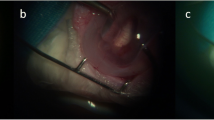Abstract
Background: Besides the direct destruction of the non-pigmented ciliary epithelium by cyclodestructive procedures, further mechanisms are responsible for the decrease of intraocular pressure. This study evaluates the alteration of the ciliary body vascularization by contact transscleral diode laser cyclophotocoagulation in rabbit eyes. Methods: Pigmented chinchilla bastard rabbits were used. Preliminary experiments were conducted to determine the parameters for diode laser cyclophotocoagulation of the pars plana or pars plicata. Then, treatment of the pars plicata (three rabbits) or pars plana (three rabbits) was performed in the right eye of six rabbits. After 2, 6 and 12 weeks histologic and transmission electron microscopic studies were performed. Furthermore, three rabbits received pars plicata cyclophotocoagulation of the right and pars plana cyclophotocoagulation of the left eye. After 2, 6 and 12 weeks, vascular casts of the ciliary body were investigated by scanning electron microscopy. Results: Histologic and transmission electron microscopic studies showed a marked coagulation necrosis with subsequent ciliary body atrophy, destruction of the ciliary epithelium, pigment dispersion in the ciliary body stroma and peripheral anterior synechiae. Examination of vascular casts of the ciliary body revealed a marked rarefication of the capillary network within the treated areas of the ciliary body in all eyes and at every time of investigation. Anterior to the laser burns the capillary network was not markedly affected in the eyes with cyclophotocoagulation of the pars plana. After 3 months short vessel sprouts were seen, but regeneration was mostly incomplete. Conclusions: The vascular casting technique is an excellent method for the investigation of changes in ciliary body vascularization after cyclodestruction. This study is the first to demonstrate a marked rarefication of the ciliary body vascularization after diode laser cyclophotocoagulation using vascular casts. The results suggest that alteration of vascularization probably acts as a strong synergistic mechanism in the decrease of intraocular pressure after cyclophotocoagulation of the pars plicata.
Similar content being viewed by others
Author information
Authors and Affiliations
Additional information
Received: 27 June 2000 Revised: 16 August 2000 Accepted: 17 August 2000
Rights and permissions
About this article
Cite this article
Schlote, T., Beck, J., Rohrbach, J. et al. Alteration of the vascular supply in the rabbit ciliary body by transscleral diode laser cyclophotocoagulation. Graefe's Arch Clin Exp Ophthalmol 239, 53–58 (2001). https://doi.org/10.1007/PL00007898
Issue Date:
DOI: https://doi.org/10.1007/PL00007898




